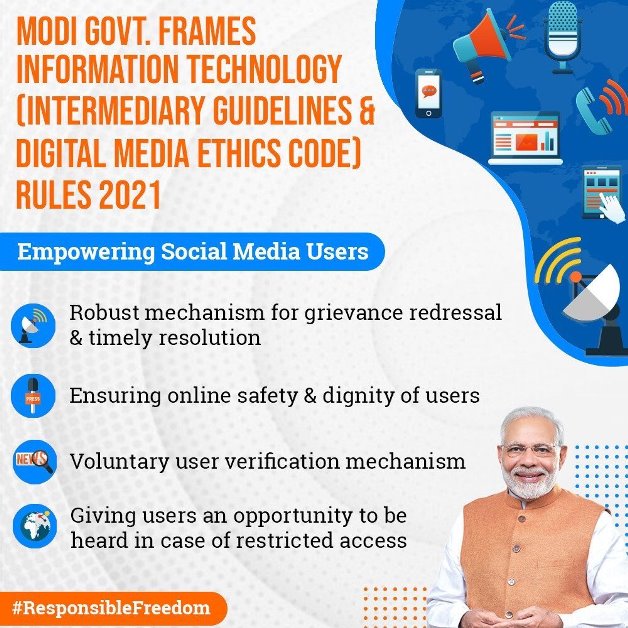The new Rules empower ordinary users of social media, embodying a mechanism for redressal and timely resolution of their grievance
 KRC TIMES Desk
KRC TIMES Desk

Background:
The Digital India programme has now become a movement which is empowering common Indians with the power of technology. The extensive spread of mobile phones, Internet etc. has also enabled many social media platforms to expand their footprints in India. Common people are also using these platforms in a very significant way. Some portals, whichpublish analysis about social media platforms and which have not been disputed, have reported the following numbers as user base of major social media platforms in India:
- WhatsApp users: 53 Crore
- YouTube users: 44.8 Crore
- Facebook users: 41 Crore
- Instagram users: 21 Crore
- Twitter users: 1.75 Crore
These social platforms have enabled common Indians to show their creativity, ask questions, be informed and freely share their views, including criticism of the Government and its functionaries. The Government acknowledges and respects the right of every Indian to criticizeand disagree as an essential element of democracy. India is the world’s largest open Internet society and the Government welcomes social media companies to operate in India, do business and also earn profits. However, they will have to be accountable to the Constitution and laws of India.
Proliferation of social media,on one hand empowers the citizens then on the other hand gives rise to some serious concerns and consequences which have grown manifold in recent years. These concerns have been raised from time to time in various forums including in the Parliament and its committees, judicial orders and in civil society deliberations in different parts of country. Such concerns are also raised all over the world and it is becoming an international issue.
Of late,some very disturbing developments are observed on the social media platforms. Persistent spread of fake news has compelled many media platforms to create fact-check mechanisms.Rampant abuse of social media to share morphed images of women and contents related to revenge porn have often threatened the dignity of women. Misuse of social media for settling corporate rivalriesin blatantly unethical manner has become a major concern for businesses.Instances of use of abusive language, defamatory and obscene contents and blatant disrespect to religious sentiments through platforms are growing.
Over the years, the increasing instances of misuse of social media by criminals, anti-national elements have brought new challenges for law enforcement agencies. Theseinclude inducement for recruitment of terrorists, circulation of obscene content, spread of disharmony, financial frauds, incitement of violence, public order etc.
It was found that currently there is no robust complaint mechanism wherein the ordinary users of social media and OTT platforms can register their complaint and get it redressed within defined timeline. Lack of transparency and absence of robust grievance redressal mechanism have left the users totally dependent on the whims and fancies of social media platforms. Often it has been seen that a user who has spent his time, energy and money in developing a social media profile is left with no remedies in case that profile is restricted or removed by the platform without giving any opportunity to be heard.
Evolution of Social Media and Other Intermediaries:
- If we notice the evolution of social media intermediaries, they are no longer limited to playing the role of pure intermediary and often they become publishers. These Rules are a fine blend of liberal touch with gentle self-regulatory framework. It works on the existing laws and statues of the country which are applicable to content whether online or offline. In respect of news and current affairs publishers are expected to follow the journalistic conduct of Press Council of India and the Programme Code under the Cable Television Network Act, which are already applicable to print and TV. Hence, only a level playing field has been proposed.
Rationale and Justification for New Guidelines:
These Rules substantially empower the ordinary users of digital platforms to seek redressal for their grievances and command accountability in case of infringement of their rights. In this direction, the following developments are noteworthy:
- The Supreme Court in suo-moto writ petition (Prajjawala case) vide order dated 11/12/2018 had observed that the Government of India may frame necessary guidelines to eliminate child pornography, rape and gangrape imageries, videos and sites in content hosting platforms and other applications.
- The Supreme Court vide order dated 24/09/2019 had directed the Ministry of Electronics and Information Technology to apprise the timeline in respect of completing the process of notifying the new rules.
- There was a Calling Attention Motion on the misuse of social media and spread of fake news in the Rajya Sabha and the Minister had conveyed to the house on 26/07/2018, the resolve of the Government to strengthen the legal framework and make the social media platforms accountable under the law. He had conveyed this after repeated demands from the Members of the Parliament to take corrective measures.
- The Ad-hoc committee of the Rajya Sabha laid its report on 03/02/2020 after studying the alarming issue of pornography on social media and its effect on children and society as a whole and recommended for enabling identification of the first originator of such contents.
Consultations:
- The Ministry of Electronics and Information Technology (MEITY) prepared draft Rules and invited public comments on 24/12/2018. MEITY received 171 comments from individuals, civil society, industry association and organizations. 80 counter comments to these comments were also received. These comments were analyzed in detail and an inter-ministerial meeting was also held and accordingly, these Rules have been finalized.
Details: Information Technology (Intermediary Guidelines and Digital Media Ethics Code) Rules 2021





